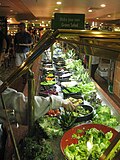Salad bar
Salad bar is a buffet-style table or counter at a restaurant or food market on which salad components are provided for customers to assemble their own salad plates.
History
The concept of the salad bar started in the United States in the mid-20th century. The first salad bar is credited to the Rax Roast Beef chain in the 1960s. The idea quickly spread to other restaurant chains and independent establishments, becoming a staple feature in many dining venues by the 1980s.
Components
A typical salad bar offers a variety of vegetables, fruits, proteins, and dressings. Common items include lettuce, tomato, cucumber, carrot, bell pepper, onion, olive, cheese, hard-boiled egg, bacon, chicken, tuna, crouton, and various types of salad dressing. Some salad bars also offer pasta salads, bean salads, and fruit salads.
Health and Nutrition
Salad bars can be a healthy dining option, as they allow customers to choose from a variety of fresh, nutrient-rich foods. However, the nutritional value of a salad bar meal can vary greatly depending on the ingredients chosen and the quantity of dressing used. Some items, such as bacon and cheese, can be high in fat and calories.
Hygiene and Food Safety
Hygiene and food safety are important considerations in the operation of a salad bar. Foods must be kept at appropriate temperatures to prevent bacterial growth, and utensils must be kept clean. Some salad bars use sneeze guards to protect the food from contamination.
Environmental Impact
The environmental impact of salad bars can be significant, due to the energy used to keep the food cold and the waste generated by disposable plates and utensils. However, some establishments are taking steps to reduce their environmental footprint, such as using reusable dishes and sourcing locally grown produce.
See Also
Salad_bar
Transform your life with W8MD's budget GLP-1 injections from $125.
W8MD offers a medical weight loss program to lose weight in Philadelphia. Our physician-supervised medical weight loss provides:
- Most insurances accepted or discounted self-pay rates. We will obtain insurance prior authorizations if needed.
- Generic GLP1 weight loss injections from $125 for the starting dose.
- Also offer prescription weight loss medications including Phentermine, Qsymia, Diethylpropion, Contrave etc.
NYC weight loss doctor appointments
Start your NYC weight loss journey today at our NYC medical weight loss and Philadelphia medical weight loss clinics.
- Call 718-946-5500 to lose weight in NYC or for medical weight loss in Philadelphia 215-676-2334.
- Tags:NYC medical weight loss, Philadelphia lose weight Zepbound NYC, Budget GLP1 weight loss injections, Wegovy Philadelphia, Wegovy NYC, Philadelphia medical weight loss, Brookly weight loss and Wegovy NYC
|
WikiMD's Wellness Encyclopedia |
| Let Food Be Thy Medicine Medicine Thy Food - Hippocrates |
Medical Disclaimer: WikiMD is not a substitute for professional medical advice. The information on WikiMD is provided as an information resource only, may be incorrect, outdated or misleading, and is not to be used or relied on for any diagnostic or treatment purposes. Please consult your health care provider before making any healthcare decisions or for guidance about a specific medical condition. WikiMD expressly disclaims responsibility, and shall have no liability, for any damages, loss, injury, or liability whatsoever suffered as a result of your reliance on the information contained in this site. By visiting this site you agree to the foregoing terms and conditions, which may from time to time be changed or supplemented by WikiMD. If you do not agree to the foregoing terms and conditions, you should not enter or use this site. See full disclaimer.
Credits:Most images are courtesy of Wikimedia commons, and templates, categories Wikipedia, licensed under CC BY SA or similar.
Translate this page: - East Asian
中文,
日本,
한국어,
South Asian
हिन्दी,
தமிழ்,
తెలుగు,
Urdu,
ಕನ್ನಡ,
Southeast Asian
Indonesian,
Vietnamese,
Thai,
မြန်မာဘာသာ,
বাংলা
European
español,
Deutsch,
français,
Greek,
português do Brasil,
polski,
română,
русский,
Nederlands,
norsk,
svenska,
suomi,
Italian
Middle Eastern & African
عربى,
Turkish,
Persian,
Hebrew,
Afrikaans,
isiZulu,
Kiswahili,
Other
Bulgarian,
Hungarian,
Czech,
Swedish,
മലയാളം,
मराठी,
ਪੰਜਾਬੀ,
ગુજરાતી,
Portuguese,
Ukrainian
Contributors: Prab R. Tumpati, MD


